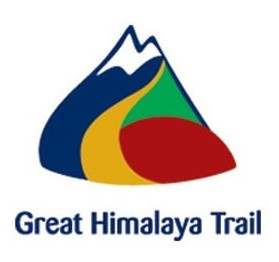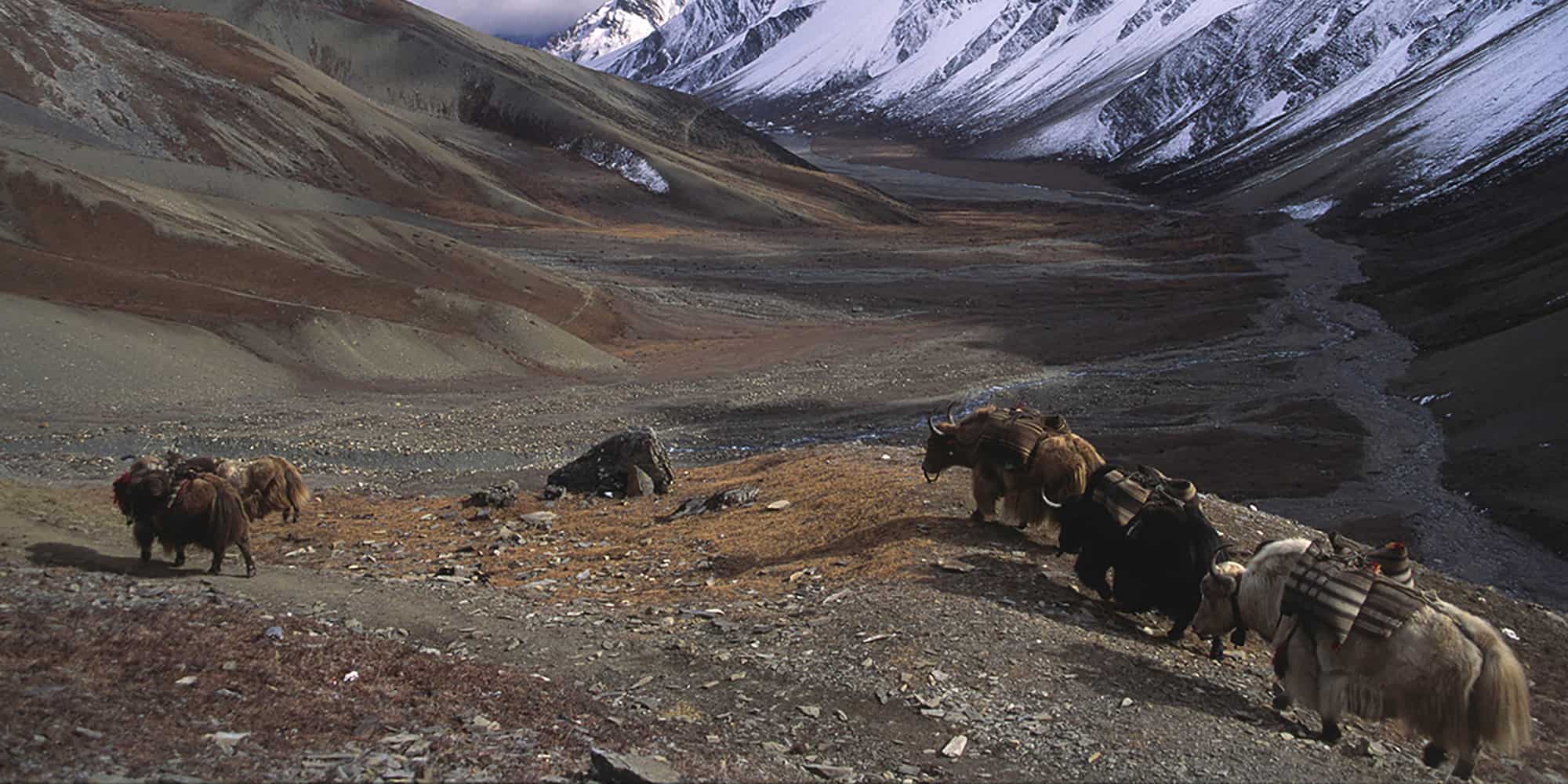GHT History – An Ancient Tradition
The Great Himalaya Trail runs through regions and countries that have cultures dating back thousands of years, and for much of the time they have been trading with each other across the mountains. Salt, wood, grains, wool and livestock, gold and gems are just a few of the products that helped to establish a network of trails from Indochina to Afghanistan, including sections of the famous Silk Route – diversity and communities have always been part of GHT History!
It is easy to imagine local traders plying trails with their yak or donkey trains throughout the region. Over centuries, they explored remote valleys trying to find the easiest trails over the never ending ‘Abode of Snow’, the Himalaya. In the larger valleys small communities sprang up and developed their own unique languages and traditions. For over a thousand years the people of the Himalaya were cut off from the rest of the world as Ladakh, Nepal, Sikkim, Bhutan and Tibet all kept their borders closed from prying colonial eyes.
The First Europeans
Jesuit missionaries were the first Europeans to penetrate deep into the Himalaya in the early seventeenth century. The first was Father Antonio Andrade, in 1626, who crossed from India to western Tibet and then enjoyed the local Tibetan’s open-minded hospitality, that still exists today. However, it was William Moorcroft who is considered the father of modern Himalayan exploration. His first trip, in 1812, was in search of Tibetan goats to trade cashmere; another followed this in 1819-25, when he disappeared without a trace. In his wake came a long succession of missionaries, botanists, geographers and traders who criss-crossed the mountain ranges from east to west and began mapping the himals. Exploration activity increased from the 1850s with the Great Game, a period when the British Raj, Russian Tsar and Chinese Qing empires all vied for ascendancy in the region.
The Sport of Mountaineering
The then new ‘sport’ of mountain climbing arrived in the Himalaya in the 1880s with W. W. Graham, Sir Martin Conway and Douglas William Freshfield who pushed deep into the unexplored valleys of Sikkim and the Karakorum. However, most of the Himalayan Kingdoms still discouraged visitors, leaving many areas ‘blanks on the map’. After the First World War, a number of expeditions were organised to reconnoitre and climb significant peaks. However, it was the mysterious disappearance of Mallory and Irvine on Mt Everest in 1924 that really ignited the world’s imagination for Himalayan exploration, and was a precursor to the successful expedition led by Lord Hunt that placed Sir Edmund Hillary and Tenzing Norgay on the summit on the 29th May 1953.






Birth of Himalayan Trekking
It was the research expeditions to identify new peaks and climbing routes that began what we now call ‘trekking’. In 1949, Bill Tilman visited the Helambu, Langtang, Everest and Kali Gandaki valley regions intent on walking through valleys rather than climbing any specific peak, and so became the first Himalayan ‘trekker’. In 1965, Lieutenant Colonel Jimmy Roberts introduced the world to organised trekking holidays and began a revolution in adventure holidays that made regions of the Himalaya accessible to anyone.
All of the activity to date was largely north to south across the Himalayan ranges, so when an east to west route along the entire range was suggested in the 1970s it was considered a radical idea. Yet the challenge had been set: who could be the first to traverse the entire range?
Recent GHT History
At the time, the eastern ranges through Bhutan and Tibet were closed, so attempts could only start in Sikkim, an autonomous region of India. In 1980, Harish Kohli lead an Indian Army team who operated in relay, traversed an undocumented route from Sikkim to Ladakh. However, the first unbroken Himalayan traverse was by Peter Hillary (son of Sir Edmund), Graeme Dingle and S. P. Chamoli in 1981, which was fully documented in ‘First Across the Roof of the World’. Their story is a true mountain epic that began at Kanchenjunga, on the border of Nepal and Sikkim and ended in Concordia at the base camp of K2.
A nine-month trek over 1981-82 saw Hugh Swift and Arlene Blum complete a traverse from Bhutan to Ladakh in India (Blum documented her story in ‘Breaking Trail’). In 1983, the Crane brothers (Adrian and Richard) ran 3200km (2000 miles) from Darjeeling (Sikkim) to Pakistan, thus setting a record, which has yet to be broken (the Crane’s story, ‘Running the Himalayas’). This was to remain the longest attempt until 1990, when Sorrell Wilby and her husband Chris Ciantar, made a traverse from Pakistan to Arunchal Pradesh (northern Assam in India), which included nearly every Himalayan region (documented in Wilby’s book, ‘Across the Top’). In 1994, the French duo of Paul-Eric Bonneau and Bruno Poirier crossed the Nepal Himalaya in 42 days (October 21 – December 1, 1994) from Pashupatinagar to Mahakali (see their book, ‘Trans-Nepal-Himalaya’). Then in 1997, two Frenchmen, Alexandre Poussin and Sylvain Tesson, embarked on an epic adventure along the Himalaya (Bhutan to Tajikistan) that involved getting arrested in three countries – Tibet, Pakistan and Tajikistan. Their journey (published as ‘La Marche dans le Ciel’) really pushed the boundaries of what was considered to be ‘Himalayan’.
The GHT History of Today
Since 1997, there were many attempts to traverse the Himalaya by walking, running and biking, but all of these expeditions suffered from restrictions on where they could visit. Closed and restricted areas meant trekkers often had to detour to the pahar, away from the Great Himalaya Range. Even Nepal, perhaps the most accessible of the countries, had strict ‘no-go’ areas along the border with Tibet. In 2002, things changed and Nepal opened every one of her himals to permit-based trekking. Along with new trekking areas in Bhutan and India, the Great Himalaya Range was completely opened to trekkers for the first time in history.
The first person to take advantage of the newly opening regions of Nepal was Rosie Swale-Pope, who ran across Nepal in 2003. Her 1700km mid-hills route from Taplejung to Simikot was an early precursor to the current Great Himalaya Trail concept. Dr Gillian Holdsworth walked a similar route in 2007, which is documented on the British Nepal Medical Trust website. From early 2004, Robin Boustead (the author) systematically researched and documented each of the newly opened trekking regions over four years, culminating in a 162-day high traverse of Nepal’s himals from September 2008 to July 2009. His trek was the first crossing to link every himal and thus created the GHT as it is known today. Between 2008 and 2011, Jean-Claude Latombe walked across Nepal in two sections of 56 and 53 days and his website has a wonderful collage of images of the people and landscapes he encountered. From then until 2018, there have been about one hundred documented high traverses of the Nepal Himalaya and many hundreds of trekkers have completed regional sections.
See GHT Community for more information.

The kani (gateway) to Samdo village.
Transform Yourself on the GHT History Highway!
Each of these journeys was different, a clear example of how the Great Himalaya Trail is a personal challenge along a trail system that allows you to develop your own route priorities and set your own goals. Treks can be as short as just 5 or 6 days at low elevation through to extreme journeys of months at high altitude. For some, the ultimate Great Himalaya Trail challenge follows a trail network that links the ‘highest feasible route’ along the length of the various himals. However, weather and time restrictions mean that trekkers often choose sections that by-pass technical passes or navigation problem areas. So, linking village trails with higher routes has become the accepted norm when designing itineraries. The GHT has become a way to immerse yourself in Himalayan cultures and challenge your boundaries – there truly is a trail for everyone!
Get Planning…
We’ve tried to put everything you need to know to plan and trek your GHT adventure on this website, but maybe we’ve missed something? Or you have some more detail or have questions? If so, please feel free to Get in Touch.













